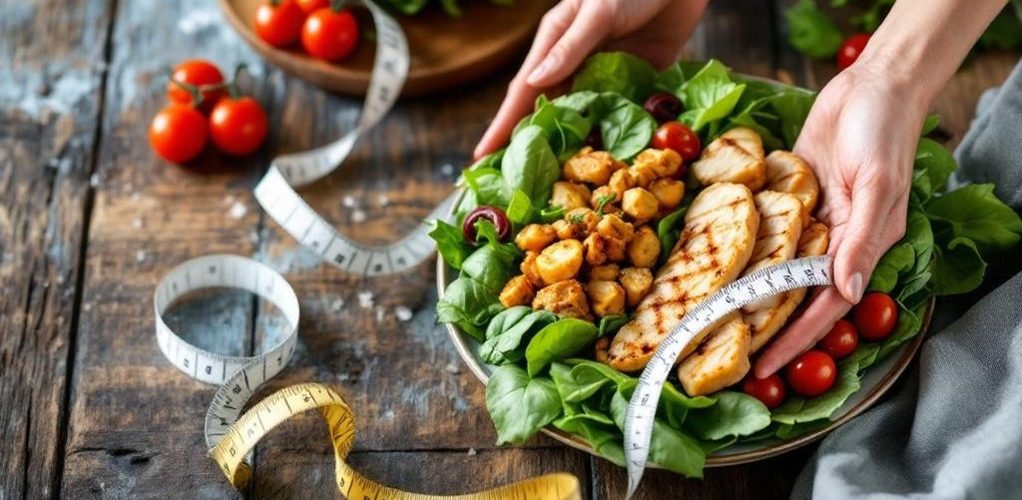Calculating macros for weight loss can be simplified using hand portions. This method allows individuals to estimate their dietary needs without complex measurements. It emphasizes protein, carbohydrates, and healthy fats while incorporating non-starchy vegetables for added nutrients. Understanding how to use hand sizes as a guide can lead to balanced meals tailored to personal goals. However, effective application of this method requires a deeper exploration of each macronutrient and its role in weight management—especially for readers exploring related resources and asking what is warriorBabe.
Understanding Macros: What They Are and Why They Matter
Macros, short for macronutrients, are the essential nutrients that provide the body with energy and support various physiological functions. There are three primary types of macronutrients: carbohydrates, proteins, and fats. Each macronutrient plays a unique role in the body; carbohydrates serve as the body’s main energy source, proteins are important for muscle repair and growth, and fats support cell structure and hormone production. Understanding the balance of these macronutrients is significant for anyone aiming for weight loss. A well-structured macro plan can help regulate hunger, maintain muscle mass, and enhance metabolic efficiency. By prioritizing the right proportions of each macronutrient, individuals can effectively tailor their diets to meet their weight loss goals while ensuring overall health and well-being. Additionally, much like social enterprises that address pressing social issues, a well-balanced macro approach can promote sustainable health outcomes.
The Hand Portion Method Explained
For those seeking a practical approach to managing macronutrient intake, the Hand Portion Method offers a simple yet effective way to gauge portion sizes without the need for complex calculations. This method utilizes the individual’s hands as a visual guide, making it easy to estimate appropriate servings. Typically, a palm-sized portion represents protein, while a fist-sized portion indicates vegetables. Carbohydrates can be measured using cupped hands, and healthy fats are often equivalent to a thumb-sized portion. This intuitive system helps individuals maintain portion control, ensuring they meet their nutritional goals while promoting weight loss. By relying on familiar hand sizes, users can easily adapt this method to various foods, creating a sustainable and flexible approach to healthy eating. Additionally, continuous learning about nutrition can enhance the effectiveness of this method and support long-term weight loss goals.
Calculating Your Protein Needs
Protein intake plays an essential role in weight loss, as it helps preserve muscle mass while promoting satiety. To determine appropriate portion sizes, individuals must consider their body weight and activity level. Adjusting protein needs based on physical activity can further enhance the effectiveness of a weight loss plan. Additionally, understanding the interconnectedness of physical and mental health can further motivate individuals to adhere to their dietary goals.
Importance of Protein Intake
Understanding the significance of protein intake is essential for anyone aiming to lose weight effectively. Protein plays a critical role in preserving lean muscle mass during weight loss, which is important for maintaining metabolic rate. A higher protein intake can enhance satiety, reducing overall calorie consumption. Additionally, protein has a higher thermic effect compared to fats and carbohydrates, meaning the body expends more energy digesting it. This can aid in creating a calorie deficit, crucial for weight loss. The recommended protein intake varies based on individual factors such as age, activity level, and weight loss goals. Ultimately, prioritizing protein in one’s diet can support both weight loss efforts and overall health.
Determining Portion Sizes
Calculating protein needs accurately is essential for anyone focused on effective weight loss. As warriorbabe emphasizes, protein intake supports muscle maintenance and enhances satiety, making it a pivotal part of a weight loss plan. To determine the appropriate portion sizes, one method involves using hand portions. A serving of protein, such as chicken or fish, is roughly the size of the palm. For plant-based proteins like beans or lentils, a portion can be represented by a cupped hand. It is generally recommended that individuals consume between 0.6 to 1 gram of protein per pound of body weight, depending on personal goals. By using these visual cues, individuals can easily adjust portion sizes to meet their dietary needs without the hassle of weighing and measuring every meal.
weighing food.
Adjusting for Activity Level
How does one accurately adjust protein intake based on activity level? To tailor protein needs effectively, individuals should first assess their activity intensity. Sedentary individuals may require approximately 0.8 grams of protein per kilogram of body weight, while those engaging in moderate exercise might increase their intake to 1.2 grams. For athletes or those involved in intense training, protein requirements can rise to 1.6 to 2.0 grams per kilogram. Additionally, considering the type of exercise—endurance versus strength training—can influence protein needs. Tracking personal progress and adjusting intake accordingly guarantees ideal muscle recovery and growth. Ultimately, aligning protein consumption with activity levels supports weight loss goals while promoting overall health and performance.
Estimating Carbohydrate Intake
Estimating carbohydrate intake is essential for anyone aiming to lose weight while maintaining energy levels. Carbohydrates serve as a primary energy source, making it vital to find the right balance during a weight loss journey. A practical approach involves using hand portions as a guide. Typically, one serving of carbohydrates can be represented by a cupped hand, which equates to about 30-45 grams, depending on individual needs. For those engaging in regular physical activity, slightly higher carbohydrate portions may be beneficial to support performance and recovery. Monitoring carbohydrate intake helps individuals avoid excessive consumption while still providing the necessary fuel for daily activities. By estimating carbohydrate intake accurately, individuals can align their nutrition with their weight loss goals effectively. Additionally, learning from mistakes in dietary habits can lead to enhanced resilience in achieving weight loss objectives.
Determining Healthy Fats
Incorporating healthy fats into a weight loss diet plays a significant role in overall nutrition. Healthy fats, such as those found in avocados, nuts, seeds, and olive oil, contribute essential fatty acids and fat-soluble vitamins. They help enhance satiety, preventing overeating and contributing to sustained energy levels. When determining healthy fat portions, it is beneficial to use the palm of the hand as a guide, recommending about one to two servings per meal. This method simplifies portion control while ensuring adequate intake of beneficial fats. Additionally, it is important to minimize saturated and trans fats, commonly found in processed foods, as they can hinder weight loss efforts. Prioritizing healthy fats can lead to improved health outcomes and effective weight management. Moreover, the transition to renewable energy can also influence food production and dietary choices by promoting sustainable agricultural practices.
Putting It All Together: Building Balanced Meals
As individuals commence on their weight loss journey, understanding how to build balanced meals becomes essential for success. A balanced meal typically comprises a source of protein, healthy fats, and carbohydrates, all proportioned according to hand portions. For instance, a palm-sized portion of lean protein, a fistful of whole grains or starchy vegetables, and a thumb-sized serving of healthy fats can create an ideal meal structure. Incorporating non-starchy vegetables, which should fill half the plate, enhances nutrient intake without adding excessive calories. By combining these components thoughtfully, individuals can guarantee they are meeting their macro requirements while enjoying a variety of flavors and textures. Consistency in meal planning and preparation further supports adherence to this balanced approach, promoting sustainable weight loss.
Tips for Sticking to Your Hand Portion Plan
Sticking to a hand portion plan can greatly enhance weight loss success, and several practical strategies can help individuals remain consistent. First, preparing meals in advance allows individuals to portion out food according to their hand measurements, reducing the temptation to overeat. Keeping a visual reminder, such as a portion guide, can reinforce proper serving sizes during meals. Additionally, using smaller plates can create the illusion of a fuller plate, aiding in portion control. Staying mindful while eating, focusing on flavors and textures, can help individuals recognize satiety cues. Ultimately, establishing a routine and setting specific mealtimes can promote adherence to the hand portion plan, making it easier to integrate into daily life.
Tracking Progress and Making Adjustments
Tracking progress is essential for anyone aiming to lose weight through macro calculations. Individuals should regularly monitor body changes to assess the effectiveness of their current plan. Based on these observations, adjusting portion sizes may be necessary to continue making progress towards their goals.
Monitor Body Changes
Monitoring body changes is essential for anyone aiming to lose weight effectively. Regularly tracking metrics such as weight, body measurements, and body composition can provide valuable insights into progress. These observations help to identify trends and patterns, allowing individuals to assess the effectiveness of their macro calculations and overall diet. It is important to record these changes consistently, using a journal or digital app, to maintain an accurate account over time. Additionally, monitoring energy levels, workout performance, and overall well-being can offer further indicators of progress beyond the scale. By keeping a close eye on these factors, individuals can remain motivated and informed, ensuring their weight loss journey is on the right track.
Adjust Portion Sizes
Adjusting portion sizes is a crucial step in fine-tuning a weight loss plan based on individual progress. As individuals monitor body changes, they may find that their initial portion sizes need modification to align with their evolving needs. For instance, if weight loss plateaus or energy levels fluctuate, recalibrating portion sizes can help reignite progress.
Tracking daily food intake allows for a better understanding of how much is consumed versus what is needed. By using hand portions as a guide, individuals can easily adjust servings of proteins, carbohydrates, and fats. Regularly reassessing these sizes guarantees that the diet remains effective and sustainable, ultimately supporting continued weight loss and promoting overall health.
Frequently Asked Questions
Can I Use Other Body Parts for Portion Sizing?
Yes, other body parts can be used for portion sizing. For instance, a fist can represent a serving of grains, while a thumb can indicate fat portions, providing alternative methods for estimating food quantities.
How Do I Adjust Macros When Exercising More?
To adjust macros when exercising more, one should increase protein intake for muscle repair, slightly raise carbohydrates for energy, and monitor fat intake to maintain overall balance, ensuring adequate nutrition supports enhanced physical activity without compromising weight loss goals.
What if I Have Dietary Restrictions or Allergies?
Individuals with dietary restrictions or allergies should consult a nutritionist to adjust their macro ratios accordingly, ensuring they meet nutritional needs while avoiding allergens. Substituting safe foods can help maintain balance and support weight loss goals.
Can Children Use the Hand Portion Method?
Children can use the hand portion method, but it’s crucial to tailor portions according to their individual growth needs and activity levels. Consultation with a pediatric nutritionist guarantees appropriate guidelines for healthy development.
How Often Should I Recalculate My Macros?
Macros should be recalculated every few weeks or after significant weight changes, lifestyle alterations, or fitness goals adjustments. Regular reassessment helps guarantee nutritional needs align with evolving health objectives and personal progress.
Conclusion
In summary, calculating macros for weight loss using hand portions offers a practical and intuitive approach to meal planning. By understanding individual protein needs, estimating carbohydrate intake, and incorporating healthy fats, individuals can create balanced meals that align with their weight loss goals. Regularly reassessing these portions guarantees ongoing progress and adaptability. With dedication and mindful tracking, this method can effectively support a healthier lifestyle and sustainable weight management.



